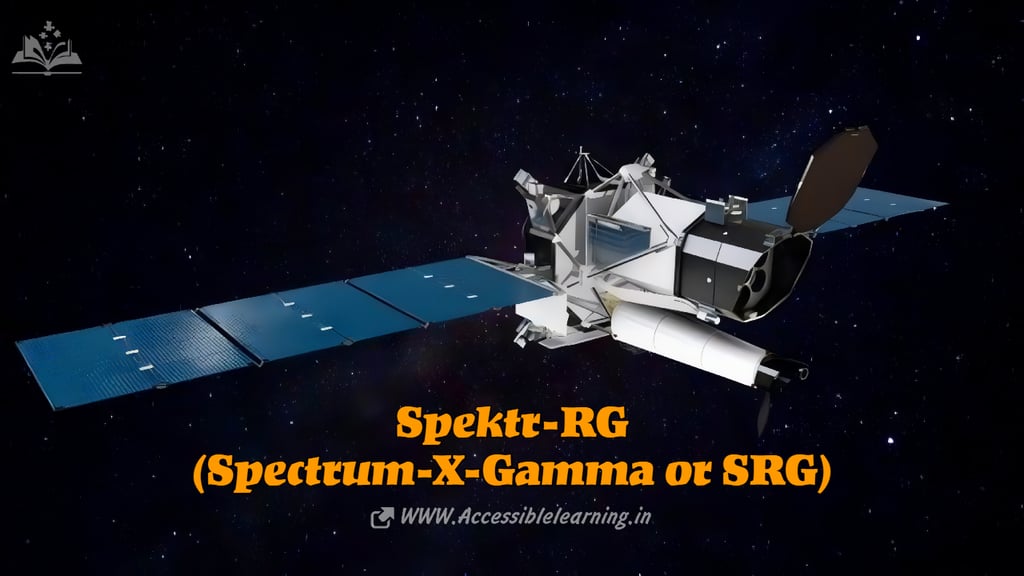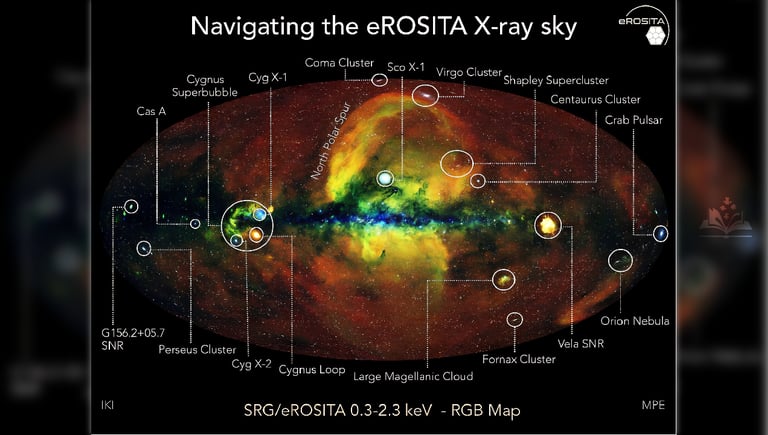
Spektr-RG (Spectrum-X-Gamma or SRG): A Revolutionary Space Observatory
Spektr-RG (Spectrum-X-Gamma or SRG) is a revolutionary space observatory designed to map the X-ray sky with unprecedented accuracy. Jointly developed by Russia’s Roscosmos and Germany’s DLR, this mission is transforming our understanding of black holes, dark matter, and cosmic evolution. Discover how Spektr-RG's eROSITA and ART-XC telescopes are reshaping X-ray astronomy and uncovering the mysteries of the universe.
SPACE/TECHEDUCATION/KNOWLEDGEISRO/NASASPACE MISSION
Sachin K Chaurasiya
3/28/20255 min read


Spektr-RG (also known as Spectrum-X-Gamma or SRG) is a groundbreaking space observatory designed to map the entire X-ray sky with unprecedented accuracy. Developed jointly by Russia’s Roscosmos and Germany’s DLR (Deutsches Zentrum für Luft- und Raumfahrt), this mission aims to provide invaluable insights into the structure of the universe, dark matter, and the evolution of galaxies. Launched on July 13, 2019, from the Baikonur Cosmodrome in Kazakhstan, Spektr-RG has been instrumental in uncovering hidden celestial objects and cosmic phenomena.
Mission Objectives
The primary goal of Spektr-RG is to conduct a high-resolution X-ray sky survey, focusing on the following objectives:
Mapping galaxy clusters to understand large-scale cosmic structures.
Studying black holes and neutron stars through their X-ray emissions.
Detecting dark matter interactions by analyzing cosmic X-ray background radiation.
Observing transient cosmic events, such as supernovae and gamma-ray bursts.
Identifying the evolution of supermassive black holes across cosmic history.
Understanding the role of hot plasma in galaxies and clusters, which affects cosmic evolution.
Key Instruments on Spektr-RG
Spektr-RG carries two advanced X-ray telescopes that work together to create a comprehensive survey of the universe:
eROSITA (Extended ROentgen Survey with an Imaging Telescope Array)
Developed by the Max Planck Institute for Extraterrestrial Physics (MPE) in Germany.
Specializes in soft X-rays (0.2–10 keV) and is responsible for producing the most detailed all-sky X-ray map ever created.
Expected to detect millions of supermassive black holes, providing crucial data on cosmic evolution.
Helps in studying the intergalactic medium and cosmic web structures.
ART-XC (Astronomical Roentgen Telescope – X-ray Concentrator)
Covers hard X-rays (4–30 keV) and enhances the detection of high-energy X-ray sources like neutron stars and black holes.
Complements eROSITA’s findings by capturing higher-energy radiation.
Plays a crucial role in identifying active galactic nuclei (AGN) and compact objects.


Orbital Details and Operations
Unlike many previous X-ray observatories, Spektr-RG operates from the L2 Lagrange point, located about 1.5 million kilometers from Earth. This position provides a stable observational environment, free from interference caused by Earth’s radiation belts, allowing for long-term, uninterrupted surveys.
The mission is designed to complete at least eight full-sky X-ray surveys over a period of six years, significantly improving our understanding of the universe’s structure and expansion.
Additionally, the L2 point allows for efficient thermal stability and minimal fuel consumption, ensuring longevity and accuracy in observational data.
Major Discoveries and Scientific Contributions
Since its launch, Spektr-RG has made several important discoveries:
Unveiling the largest catalog of X-ray sources, including millions of black holes, neutron stars, and galaxy clusters.
Providing crucial data on dark matter distribution by mapping the X-ray emission from cosmic structures.
Observing active galactic nuclei (AGN), helping scientists understand the feeding mechanisms of supermassive black holes.
Detecting ultra-bright X-ray flares, which are key to studying cosmic events like tidal disruption events (TDEs), where a star is torn apart by a black hole.
Refining models of cosmic expansion by observing how massive galaxy clusters evolve over billions of years.
Identifying X-ray signatures of merging galaxies, shedding light on galaxy evolution and star formation activity.
Spektr-RG vs. Previous X-ray Observatories
Spektr-RG stands out among previous X-ray observatories like ROSAT, Chandra, and XMM-Newton due to its unique capabilities:
Wider Energy Range—Combining soft and hard X-ray observations for a more complete cosmic picture.
All-Sky Survey Ability—Unlike Chandra and XMM-Newton, which focus on specific targets, Spektr-RG performs a continuous full-sky survey.
Longer Mission Duration—Designed for at least six years of operation, ensuring long-term monitoring of cosmic changes.
Higher Sensitivity—The eROSITA telescope has nearly 20 times the sensitivity of previous soft X-ray telescopes, enabling it to detect fainter sources.


Challenges and Future Prospects
Despite its success, Spektr-RG has faced challenges, including:
Operational delays due to initial funding and technical issues.
Complexity of data processing, requiring advanced AI-driven techniques to analyze massive datasets.
Geopolitical tensions, particularly between Russia and Germany, have impacted collaborative efforts in scientific operations.
Potential extension of the mission, as scientists explore the possibility of continuing operations beyond the initial six-year timeframe.
Developments in future space observatories, such as the Lynx X-ray Observatory and Athena (Advanced Telescope for High Energy Astrophysics), which may build upon Spektr-RG’s findings.
However, scientists remain optimistic about the mission’s impact. Future extensions or potential follow-up missions could further refine X-ray astronomy and deepen our understanding of the cosmos.
FAQ
What is Spektr-RG (SRG), and why is it important?
Spektr-RG (Spectrum-X-Gamma or SRG) is an advanced space observatory designed to conduct a high-resolution X-ray survey of the entire sky. It helps scientists study black holes, galaxy clusters, dark matter, and cosmic evolution, making it one of the most significant astrophysical missions of recent times.
What are the key instruments onboard Spektr-RG?
eROSITA (Extended ROentgen Survey with an Imaging Telescope Array): Specializes in soft X-rays (0.2–10 keV) and provides high-sensitivity sky surveys.
ART-XC (Astronomical Roentgen Telescope – X-ray Concentrator): Focuses on hard X-rays (4–30 keV), enhancing the detection of high-energy objects like black holes and neutron stars.
How does Spektr-RG compare to previous X-ray telescopes like Chandra and XMM-Newton?
Unlike Chandra and XMM-Newton, which primarily conduct targeted observations, Spektr-RG is designed for a full-sky survey. It also has a broader energy range, higher sensitivity, and the ability to detect millions of new black holes and galaxy clusters that were previously unknown.
Where is Spektr-RG located in space?
Spektr-RG operates from the L2 Lagrange point, about 1.5 million kilometers from Earth. This location provides a stable environment with minimal interference, allowing for long-term, uninterrupted observations of the cosmos.
What major discoveries has Spektr-RG made so far?
Mapped millions of X-ray sources, including black holes and galaxy clusters.
Detected transient cosmic events, such as supernovae and tidal disruption events (TDEs).
Improved our understanding of dark matter distribution by mapping X-ray emissions from massive structures.
Observed the evolution of supermassive black holes, helping refine models of cosmic expansion.
What challenges has the mission faced?
Spektr-RG has encountered challenges such as funding delays, data processing complexities, and geopolitical tensions between Russia and Germany. However, the mission continues to provide invaluable data for astrophysical research.
What is the future of Spektr-RG?
Spektr-RG is expected to continue operations beyond its initial six-year mission, with scientists proposing extended surveys and additional data analysis projects. Future X-ray observatories like Lynx and Athena may build upon its discoveries.
Spektr-RG is revolutionizing X-ray astronomy by providing unparalleled insights into the structure and evolution of the universe. With its cutting-edge telescopes and long-term sky surveys, the mission is reshaping our understanding of black holes, dark matter, and galaxy formation. As data continues to pour in, Spektr-RG remains one of the most important astrophysical missions of the modern era, offering a treasure trove of information for researchers worldwide.
Subscribe To Our Newsletter
All © Copyright reserved by Accessible-Learning Hub
| Terms & Conditions
Knowledge is power. Learn with Us. 📚


